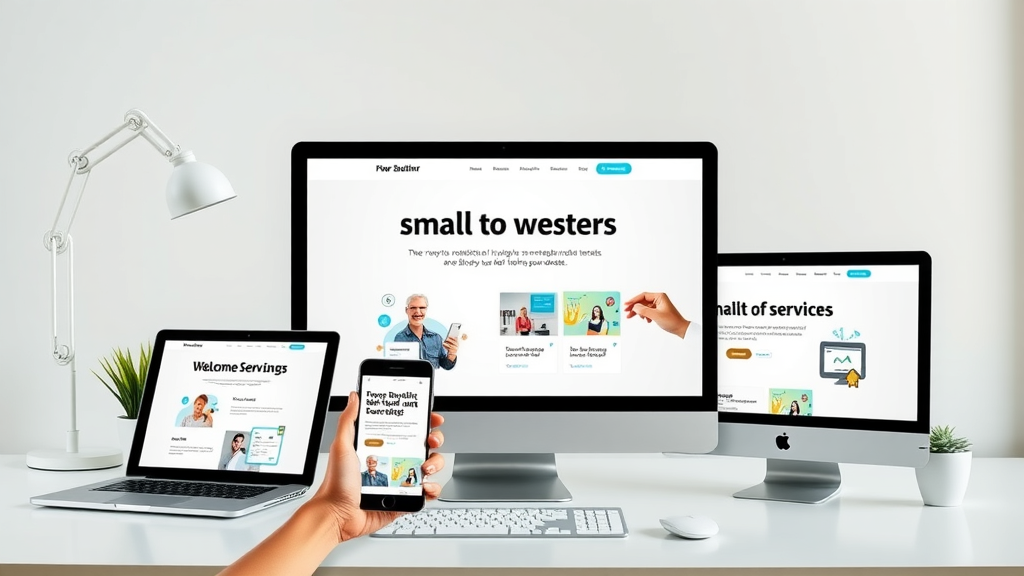- Did you know that over 70% of small businesses struggle to maintain an effective online presence? Yet, companies that actively invest in online marketing for small businesses experience up to 3.3 times more revenue growth. In today’s connected marketplace, mastering online marketing for small businesses is not just an option—it’s a necessity for survival and scalability.
- What you’ll discover in this complete guide to online marketing for small businesses:
- The essential components of digital marketing for small businesses
- How to choose the right social media platforms and craft winning content
- Smart strategies for boosting your online presence and outranking competitors
- Proven marketing tools, techniques, and tips designed for tight budgets
- Real-world examples, expert advice, and actionable checklists
Understanding Online Marketing for Small Businesses

- Explore the fundamentals of online marketing for small businesses and why a robust online presence is critical in the digital age. Real-life scenarios highlight transformation through digital marketing for small businesses.
Online marketing for small businesses fundamentally shifts how brands connect with their target audience. In today’s marketplace, a strong online presence isn’t simply a nice-to-have—it’s essential for small businesses aiming to attract new customers and retain loyal ones. From search engines and social media to email campaigns and content marketing, every digital touchpoint is an opportunity to build awareness and drive action. A classic example is the local bakery that used targeted Facebook ads and Google My Business to double foot traffic; such transformation stories are now the norm, not the exception. Whether you offer products or services, digital marketing gives even the smallest operation the tools to compete alongside larger enterprises.
Many small businesses make the mistake of equating online marketing only with having a website. In reality, successful online marketing strategies include blending multiple channels—website, email, social media, and paid ads—to form a cohesive, customer-focused approach. By leveraging these diverse digital marketing tools, you boost your online presence , improve your visibility in search results, and reach potential customers right where they’re already spending time.
Key Benefits of Online Marketing for Small Businesses
- Enhanced brand visibility
- Precise targeting of your ideal audience
- Higher return on marketing investment
- Flexibility and scalability in campaigns
- Competitive edge in crowded markets

"In today’s marketplace, online marketing for small businesses isn’t a luxury—it’s a fundamental requirement for growth and longevity." – Digital Marketing Expert
Harnessing online marketing opens a world of benefits for small businesses. First, digital marketing significantly expands your brand visibility beyond geographic and budget limitations. Through sophisticated marketing tools such as Google My Business, you can appear in local search engine results, catching the eye of potential customers precisely when they’re looking for products or services you offer. Enhanced targeting options across digital channels mean your message reaches the right audience, improving cost effectiveness and conversion chances.
Online marketing tools deliver higher returns on marketing investment compared to traditional methods. Campaigns on platforms like Facebook, Instagram, or Google Ads allow small businesses to set and adjust their marketing budget in real time, scaling up strategies or pausing them instantly based on performance. Moreover, digital marketing delivers powerful analytics, helping you refine your marketing efforts, target audience, and overall strategy to further elevate your business growth.
Perhaps most importantly, leveraging digital marketing enables small businesses to compete with—and sometimes outperform—larger competitors in crowded online marketplaces. By being nimble, creative, and data-driven, your small business can build a memorable digital brand and drive sustainable results.
Crafting Effective Marketing Strategies for Small Businesses
Defining Your Target Audience in Online Marketing for Small Businesses

The cornerstone of any successful online marketing strategy is a clearly defined target audience . For small businesses, this means digging deep into demographic, psychographic, and behavioral characteristics of ideal customers. Start by analyzing previous sales data, customer feedback, and analytics from your website and social media platforms . This allows you to construct detailed buyer personas, which inform not only your messaging but also your preferred content formats—whether blog posts, videos, or case studies.
Using insights from your audience research, you can tailor your marketing efforts, ensuring they speak directly to the needs and interests of potential customers. For example, if analytics show a majority of your customers interact via Instagram, investing more in visual content could yield greater engagement. Regularly reviewing and adapting your target audience profiles is essential—consumer preferences shift quickly in the digital world!
Segmenting your audience is another powerful approach, especially for email marketing . By categorizing contacts based on interests, purchase history, or engagement level, your campaigns become more relevant and effective—paving the way for increased open rates and conversions for your small business.
Selecting the Right Social Media Platforms for Small Business Success
Choosing the most effective social media platforms isn’t about being everywhere at once. Instead, focus on where your target audience is most active and engaged. For example, local restaurants often thrive on Facebook and Instagram, while B2B consultants might find more success networking on LinkedIn. Each platform has unique features that can propel small businesses forward, such as Instagram Shopping for product-driven brands or Twitter threads for real-time customer service.
The right social media platform becomes a key driver of brand awareness and customer loyalty. It’s important to consider not only the platform’s reach but also its alignment with your content strategy, marketing budget, and business goals. For emerging brands with tight budgets, focusing on one or two high-potential platforms allows for a concentrated, high-quality marketing effort—leading to better results without overstretching your resources.
Keep in mind, effective media marketing goes beyond creating accounts; it involves regular posting, creative content formats, and continuous engagement with your audience. Evaluate your progress through in-platform analytics and adapt your strategy for maximum impact.
Aligning Digital Marketing with Business Goals for Small Businesses
Strategic alignment is the secret sauce behind every successful online marketing effort . For small businesses, digital marketing goals should mirror your broader business objectives—whether it’s increasing monthly website traffic, generating more leads from local search engines, or boosting sales of a specific product or service.
Setting SMART goals (Specific, Measurable, Achievable, Relevant, Time-bound) allows every marketing tool or campaign you implement to contribute directly to your company’s growth. For example, if your business goal is to grow your email list by 20% in the next quarter, every email marketing tactic—like offering lead magnets or running targeted Facebook ads—should be mapped to this outcome.
Small businesses must also regularly assess whether their marketing strategies are driving the intended results. Through KPI tracking and performance reviews, weak points in your strategy can be optimized, ensuring your digital marketing budget is consistently invested in initiatives delivering real business value.
Essential Online Marketing Tools for Small Businesses
| Tool | Purpose | Free Version? |
|---|---|---|
| Mailchimp | Email marketing | Yes |
| Canva | Visual content creation | Yes |
| Hootsuite | Social media scheduling | Yes |
| Google Analytics | Web analytics | Yes |
| Buffer | Social media management | Yes |
Selecting the right marketing tools is vital for small businesses with limited time and resources. Platforms like Mailchimp make email marketing accessible, enabling even non-technical users to send effective newsletters and automate list segmentation. Canva empowers the creation of professional visual content—a major asset across social media and your website—without the need for a graphic designer.
Hootsuite and Buffer streamline social media scheduling and management across multiple platforms, saving critical hours each week. Most valuable of all, Google Analytics helps small businesses track website traffic, source data on user behavior, and evaluate which channels drive the best results. These marketing tools often offer robust free features, letting you build a strong foundation before scaling up to premium solutions.
Explore these tools to identify which fit best with your current skills, business goals, and marketing budget . Remember, while tools enhance efficiency, it’s the quality of your marketing strategy and consistency of your marketing efforts that ultimately move the needle for your small business.
Building a Strong Online Presence for Small Businesses

Optimizing Your Website for Search Engines
- SEO best practices for small business websites
- Improving site speed and mobile responsiveness
- Creating landing pages that convert
Your business website is the digital storefront. Search engine optimization (SEO) ensures your site appears in relevant search results, attracting organic traffic from potential customers. For small businesses , following SEO best practices—like using relevant keywords, optimizing meta tags, and structuring content for easy navigation—can lead to measurable visibility gains and higher rankings across search engines.
Improving website speed and mobile responsiveness are non-negotiable. With most users browsing on mobile devices, Google and other search engines prioritize fast, mobile-friendly sites in their search results. Use tools like Google’s PageSpeed Insights to identify improvements, and make navigation intuitive so visitors easily access products or services.
Don’t overlook landing pages—they are key conversion points for your online marketing campaigns. Effective landing pages are visually appealing, have minimal distractions, and feature clear calls to action (“Book Now,” “Download Guide,” etc.). Combine these principles, and you’ll transform casual visitors into loyal customers while maximizing your online presence .
Leveraging Content Marketing for Maximum Impact

- Content types: blogs, videos, infographics, case studies
- Tips for engaging your target audience with valuable information
Content marketing helps small businesses stand out as industry leaders. Whether you’re posting helpful blog articles, engaging how-to videos, insightful case studies, or eye-catching infographics, the goal is to provide genuine value to your audience. Content that answers their questions and solves their problems increases trust and positions your business as the go-to solution—so your content doesn’t just sell, it serves.
When brainstorming your content marketing plan, ask: What pain points do my customers face? Can I demonstrate my products or services in action? The right content not only brings visitors but keeps them coming back—also strengthening your SEO in the process. Consistency is key: set a publishing schedule and stick to it, whether it’s weekly blog posts or monthly video tips, always focusing on what will engage your target audience.
Promote content across your social media platforms and email list to maximize reach. Don’t forget to encourage interaction—ask for comments, reviews, or user-generated content, and always respond to build community. By delivering reliable, authentic, and engaging pieces, your small business can earn trust, boost traffic, and drive sustainable growth through content marketing .
Mastering Social Media Marketing for Small Businesses
Top Social Media Platforms for Small Businesses
| Platform | Ideal for | Unique Features |
|---|---|---|
| Local outreach, ads | Groups, Pages, Events | |
| Visual brands | IG Stories, Shopping | |
| B2B networking | Articles, Groups | |
| Real-time updates | Hashtags, Threads | |
| TikTok | Younger demographics | Viral short videos |
The right social media platform can supercharge your small business growth. Facebook is ideal for reaching local audiences and offers robust ad targeting, while Instagram’s visual-first approach works well for product or lifestyle brands. Professionals and B2B companies thrive on LinkedIn, and Twitter is essential for real-time engagement and updates. Newer entrants like TikTok offer opportunities to reach younger demographics through creative, viral videos.
Analyze data on where your target audience spends their time. For example, a bakery might focus on Instagram and Facebook for local customer engagement, while a consulting firm may get better ROI from LinkedIn. Regardless, pick platforms that fit your brand and allocate your efforts where you’ll get the most return—which is especially critical when operating with a limited marketing budget.
As your digital marketing matures, consider expanding to additional social media platforms, testing new content formats, and utilizing unique features like Instagram Shopping or Facebook Groups for added community engagement. Track performance metrics to ensure your resources are always focused on the most productive platforms.
Social Media Marketing Strategies for Small Businesses

- Consistent posting calendar
- Community engagement tactics
- Leveraging user-generated content
- Social media advertising tips
Effective social media marketing is about more than just posting content. Start by establishing a steady posting calendar that keeps your brand top of mind without overwhelming your followers. Aim for a mix of educational, entertaining, and promotional content, and always tailor your posts to suit the culture of the specific media platform—what thrives on LinkedIn might flop on TikTok!
Foster deeper connections by engaging directly with your community. Respond to comments, share customer photos, ask questions, and run interactive polls. User-generated content—like reviews and tagged posts—can boost credibility while extending your reach organically. Small businesses often see exponential audience growth just by showcasing real customers and behind-the-scenes insights into their story.
When your organic reach plateaus, invest in strategic paid campaigns. Social ads allow hyper-targeting by interests, location, and even life events. Test different content styles, copy, and creative formats (such as video versus carousel ads) to maximize your ad spend and achieve your specific goals, whether website clicks, store visits, or product purchases.
Elevating Email Marketing for Small Business Growth
Building and Segmenting Your Email List
- Best lead magnets for small businesses
- List segmentation for personalized campaigns
- Avoiding spam filters and legal pitfalls

A well-managed email list remains one of the most cost-effective assets for small businesses. Begin building your list by offering appealing lead magnets: think discount codes, free guides, or exclusive access to webinars. Make sign-up forms visible on your website, blog post, and social media pages, emphasizing the benefits of joining your email community.
Segmentation is critical. Divide your email list based on demographics, purchase behavior, or engagement. This allows highly personalized messages—such as tailored promotions or relevant advice—to increase open rates and boost conversions. Always comply with regulations like GDPR and CAN-SPAM; include clear opt-out options and never buy lists.
Navigating spam filters is another priority. Avoid spam-trigger keywords, limit exclamation points, and fully authenticate your sending domain. By cultivating a healthy, engaged list, your small business will enjoy higher deliverability and better long-term results from email marketing .
Creating Compelling Campaigns in Online Marketing for Small Businesses
- Subject line best practices
- A/B testing for improved open rates
- Timing and frequency recommendations
The secret to email marketing success? Irresistible subject lines and engaging content. Craft subject headlines that are clear, concise, and spark curiosity—sometimes, a well-placed emoji or personalization can dramatically increase open rates. Consistent A/B testing of your subject lines and email layouts is a must. Test one element at a time to identify what resonates most with your audience, and double-down on what works best.
Timing can make or break your campaign’s impact. Generally, weekday mornings and early afternoons deliver strong results, but monitor your analytics to see when your specific audience is most engaged. Avoid over-emailing; find a frequency that keeps your business top of mind but never overwhelms your subscribers. Most importantly, ensure every email delivers value—be it useful tips, exciting news, or special offers tailored for their interests.
Measure your email open and click rates regularly, and refine your campaigns for continuous improvement. Personalization, segmentation, and clear calls-to-action will transform your email marketing from background noise to a top-performing growth channel for your small business.
Boosting Results with Paid Digital Marketing: Google Ads & Beyond
Launching Your First Google Ads Campaign

- Setting clear objectives
- Choosing the right keywords for small businesses
- Budgeting tips – how much should small businesses spend?
Launching a Google Ads campaign is a tactical move for small businesses looking for rapid results. First, define your goals: are you driving online sales, increasing local store visits, or generating leads for a specific product or service? Then, research and select keywords suited to your target audience —think in terms of buyer intent (“best vegan bakery near me” or “accounting software for freelancers”).
Your marketing budget can start small; many experts suggest beginning with $300-$500/month, then scaling as you see positive return on investment. Use Google’s recommendations and bidding tools, but always monitor campaign performance closely, pausing under-performing ads and reallocating funds to what works best.
Don’t forget conversion tracking—link your website and ad platforms so every phone call, sign-up, or sale is measured. With right targeting and ongoing optimization, Google Ads can give small businesses premium visibility even in competitive markets.
Exploring Alternative Paid Marketing Tools
- Facebook and Instagram advertising
- Remarketing strategies
- Measuring ROI and optimizing ad spend
Beyond Google, Facebook and Instagram advertising open further opportunities to reach select audiences based on their interests, demographics, and behavior. Use retargeting ads to re-engage visitors who didn’t convert on their visit—remarketing is a powerful method to stay top-of-mind and prompt future purchases without extra effort.
Continually measure your return on investment (ROI) on every paid campaign. Key metrics to track include cost-per-acquisition, conversion rate, and how each campaign contributes to your larger marketing goals. Fine-tune your ads by adjusting creative, targeting, and spend according to what drives the best outcomes.
With a discipline of testing, learning, and optimizing, small businesses can maximize every dollar spent, cutting wasted budget and boosting customer acquisition through paid digital marketing.
Measuring and Improving Your Online Marketing Efforts
Key Metrics to Track in Online Marketing for Small Businesses

- Conversion rates
- Website traffic and user behavior
- Email open and click-through rates
- Social media engagement
- Cost-per-acquisition
Precise measurement is what sets apart high-performing online marketing for small businesses. Conversion rates—how many website visits result in desired actions like sign-ups or purchases—are essential, but don’t overlook data like total website traffic, top traffic sources, bounce rate, and user paths.
On the email marketing side, prioritize open rates, click-through rates, and unsubscribes. These metrics signal how well your messaging is resonating or if it’s turning off subscribers. For campaigns on social media platforms , track not just likes, but also comments, shares, and direct messages as indicators of genuine engagement.
Finally, calculate your cost-per-acquisition (CPA)—the total spend to acquire a new customer through digital marketing. Analyzing these numbers regularly allows you to reallocate resources towards top-performing channels, refine your marketing strategies , and continually increase the ROI for your marketing efforts.
Continuous Improvement: Adapting Your Marketing Strategies
- Using analytics to guide next steps
- Staying updated on online marketing trends
- A/B testing and iterative improvement
Continuous improvement is why digital marketing is so effective for small businesses. Use your analytics tools—such as Google Analytics and social media dashboards—to spot patterns and inform your next steps. Are most sales coming from Instagram posts? Double down on what works.
Remain agile. As new inbound marketing or social media trends emerge, adapt your campaigns and test new tactics. Track changes carefully and run A/B tests to find the best-performing headlines, images, or offers for your target audience. Iterative improvement based on real data is what separates small businesses that grow rapidly from those that stagnate.
Encourage a data-driven culture in your business where every marketing tool and platform is constantly optimized for the best results. Celebrate the wins and don’t be afraid to pivot—this approach keeps your online marketing effective and future-proof.
Real-World Case Studies: Online Marketing for Small Businesses in Action

- How a small bakery doubled its sales with targeted email marketing
- A consulting firm’s journey with content and social media marketing
- Lessons learned and actionable insights for your online presence
Consider the story of a small-town bakery struggling with slow foot traffic. By launching targeted email marketing campaigns (using tools like Mailchimp) and promoting special offers to a segmented list, their monthly sales doubled in just four months. They then shared customer testimonials and behind-the-scenes videos on Instagram, further expanding their loyal customer base.
Meanwhile, a boutique consulting firm committed to consistent blogging and LinkedIn article publishing. By combining thought leadership on emerging industry trends with regular community engagement, their inquiries tripled within six months—proving the compounded effect of content marketing and social media for small businesses.
The shared lesson is clear: persistent, data-driven online marketing , adapted to your business’s unique strengths and customer needs, is the catalyst for growth. Start small, track results, and iterate as you learn.
Video: Essential Online Marketing Tips for Small Businesses
- Watch how top small businesses leverage simple digital marketing strategies to stand out online and grow their customer base.
Video: Mastering Social Media for Small Business Success
- Learn step-by-step how social platforms can amplify your marketing efforts and drive results.
Video: Optimizing Google Ads for Small Businesses
- Get expert insights on campaign structure, bidding strategies, and budget best practices critical to online marketing for small businesses.
People Also Ask: How to do digital marketing for a small business?
- Digital marketing for small businesses involves building an online presence through a user-friendly website, SEO, social media marketing, email marketing, and targeted ads. Start by defining your goals, choosing appropriate channels, and tracking performance. Consistency and continuous improvement are essential.
People Also Ask: How do I market my small business online?
- To market your small business online, create quality content, define your target audience, actively use social media platforms, optimize your site for search engines, implement email marketing campaigns, and explore paid ads. Monitor results and refine your approach regularly.
People Also Ask: What is the best marketing platform for small business?
- The best marketing platform depends on your audience and goals. Facebook and Instagram are highly versatile, while LinkedIn excels for B2B. For visual brands, Instagram and YouTube work well. Evaluate each platform based on your target audience’s habits.
People Also Ask: Is digital marketing worth it for small businesses?
- Absolutely. Digital marketing allows small businesses to compete with larger players at a much lower cost. With smart strategies, tracking, and adaptation, online marketing delivers measurable returns and sustainable growth.
Expert Insights: Quotes from Digital Marketing Leaders on Online Marketing for Small Businesses
"Digital marketing levels the playing field for small businesses, enabling them to reach, engage, and convert targeted audiences cost-effectively." – Marketing Strategist
Best Practices for Budget-Friendly Online Marketing for Small Businesses
- Tap into free resources and marketing tools
- Focus on organic content and local SEO
- Collaborate with influencers in your niche
- Test and refine campaigns before scaling
Small businesses with limited marketing budgets can still achieve impressive results. Take full advantage of free digital marketing tools (like Mailchimp, Canva, and Google My Business) to lay a strong foundation. Create authentic, shareable content—such as blog posts and videos—that highlights your unique brand story and expertise.
Consider collaborating with micro-influencers in your community or niche—they often have highly engaged audiences and offer affordable promotional options. Finally, deploy a “test and learn” approach: experiment with campaigns on a small scale, analyze your results, and double down on what drives the best impact for your business.
Common Mistakes to Avoid in Online Marketing for Small Businesses
- Neglecting analytics and performance metrics
- Spreading your marketing efforts too thin
- Failing to define your target audience
- Overlooking mobile optimization
Many small businesses fall into common traps that hinder their digital marketing success. The most frequent? Ignoring analytics and failing to track performance—without regular measurement, you can’t improve. Also, avoid spreading your marketing budget across too many platforms; it’s better to excel and gain traction in one or two channels than to do poorly on five.
Never skip the crucial step of clearly defining your target audience. Without clarity on who you’re speaking to, your marketing message becomes generic and ineffective. Finally, always design with mobile users in mind—most online activity now happens on smartphones, and search engines reward mobile-optimized sites with better rankings and more traffic.
FAQ: Online Marketing for Small Businesses
- Q: How much should a small business budget for online marketing? A: Most experts recommend allocating 5-10% of gross revenue to marketing, but even a small budget can be highly effective if spent strategically.
- Q: Which is better for small businesses—SEO or paid ads? A: A combined approach works best: SEO builds long-term value and organic traffic, while paid ads offer instant, targeted reach.
- Q: Can online marketing replace traditional advertising? A: For many small businesses, online marketing brings better results at a lower cost. However, some industries still benefit from a hybrid approach.
Key Resources and Takeaways for Online Marketing for Small Businesses
- Utilize adaptable marketing tools and platforms
- Keep your online presence active and authentic
- Track results and pivot strategies as needed for best outcomes
Achieve New Growth: Take Action with Online Marketing for Small Businesses
- Ready to grow your business? Book your free marketing strategy session with our team today. Discover how online marketing for small businesses can unlock your next level of success.
To enhance your understanding of online marketing for small businesses, consider exploring the following resources:
-
“12 Online Marketing Strategies for Small Businesses” : This article outlines essential strategies such as investing in SEO, building a strong website, and leveraging local SEO to boost your online presence. ( broadly.com )
-
“16 Effective Digital Marketing Strategies for Small Businesses on a Budget” : This piece offers budget-friendly tactics, including mobile-focused ads and collaborations with micro-influencers, to effectively market your business online. ( azbigmedia.com )
These resources provide actionable insights and practical tips to help small businesses navigate the digital marketing landscape effectively.
 Add Row
Add Row  Add
Add 




Write A Comment